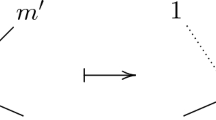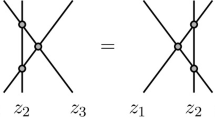Abstract
We construct a family of integrable Hamiltonian systems generalizing the relativistic periodic Toda lattice, which is recovered as a special case. The phase spaces of these systems are double Bruhat cells corresponding to pairs of Coxeter elements in the affine Weyl group. In the process we extend various results on double Bruhat cells in simple algebraic groups to the setting of Kac–Moody groups. We also generalize some fundamental results in Poisson–Lie theory to the setting of ind-algebraic groups, which is of interest beyond our immediate applications to integrable systems.
Similar content being viewed by others
References
Berenstein A., Fomin S., Zelevinsky A.: Cluster algebras III: upper bounds and double Bruhat cells. Duke Math. J. 126(1), 1–52 (2005)
Chari V., Pressley A.: A Guide to Quantum Groups. Cambridge University Press, Cambridge (1994)
Drinfel’d V.: Quantum groups. J. Soviet Math. 41(2), 898–915 (1988)
Eager, R., Franco, S., Schaeffer, K.: Dimer models and integrable systems. Preprint. arXiv:1107.1244 (2011)
Fishel S., Grojnowski I., Teleman C.: The strong Macdonald conjecture and Hodge theory on the loop Grassmannian. Ann. Math. 168(1), 175–220 (2008)
Fock, V.V., Marshakov, A.: Integrable Systems, Cluster Variables, and Dimers. In Preparation (2012)
Fomin S., Zelevinsky A.: Double Bruhat cells and total positivity. J. Am. Math. Soc. 12(2), 335–380 (1999)
Gekhtman M., Shapiro M., Vainshtein A.: Generalized Bäcklund-Darboux transformations for Coxeter–Toda flows from a cluster algebra perspective. Acta Math. 206(2), 245–310 (2011)
Goncharov, A.B., Kenyon, R.: Dimers and Cluster Integrable Systems. Preprint arXiv:1107.5588 (2011)
Hoffmann T., Kellendonk J., Kutz N., Reshetikhin N.: Factorization dynamics and Coxeter–Toda lattices. Commun. Math. Phys. 212(2), 297–321 (2000)
Kac V.: Infinite-Dimensional Lie Algebras, 3rd edn. Cambridge University Press, Cambridge (1994)
Kac V., Peterson D.: Infinite flag varieties and conjugacy theorems. Proc. Natl. Acad. Sci. USA 80(6), 1778–1782 (1983)
Kac, V., Peterson, D.: Regular Functions on Certain Infinite-Dimensional Groups. Arithmetic and Geometry. Progr. Math., vol. II, pp. 141–166. Birkhäuser, Boston (1983)
Kogan M., Zelevinsky A.: On symplectic leaves and integrable systems in standard complex semisimple Poisson–Lie groups. Int. Math. Res. Not. 2002(32), 1685–1702 (2002)
Kosmann-Schwarzbach, Y.: Lie Bialgebras, Poisson Lie Groups and Dressing Transformations. Integrability of Nonlinear Systems. Lecture Notes in Physics, pp. 104–170. Springer, Berlin (1996)
Kumar, S.: Kac–Moody Groups, Their Flag Varieties, and Representation Theory. Progr. Math., vol. 204. Birkhäuser, Boston (2002)
Lu J., Weinstein A.: Poisson Lie groups, dressing transformations, and Bruhat decompositions. J. Differ. Geom. 31(2), 501–526 (1990)
Marshakov, A.: Lie Groups, Cluster Variables and Integrable Systems. Preprint arXiv:1207.1869v1 (2012)
Mathieu, O.: Formules de Caracteres pour les Algebres de Kac–Moody Generales. Asterisque, Societe Mathematique de France, Marseilles (1988)
Nekrasov N.: Five-dimensional Gauge theories and relativistic integrable systems. Nuclear Phys. B 531(1–3), 323–344 (1998)
Reshetikhin N.: Integrability of characteristic Hamiltonian systems on simple Lie groups with standard Poisson Lie structure. Commun. Math. Phys. 242(1), 1–29 (2003)
Reyman, A., Semenov-Tian-Shansky, M.: Group-theoretical methods in the theory of finite-dimensional integrable systems. Dynamical Systems VII: Integrable Systems, Nonholonomic Dynamical Systems. Encyclopedia of Mathematical Sciences, vol. 1, p. 341. Springer, Berlin (1994)
Ruijsenaars S.: Relativistic Toda systems. Commun. Math. Phys. 133(2), 217–247 (1990)
Shafarevich I.: On some infinite-dimensional groups II. Izv. Akad. Nauk. SSSR Ser. Mat. 45(1), 214–226 (1981)
Suris Y.: Algebraic structure of discrete-time and relativistic Toda lattices. Phys. Lett. A 156(9), 467–474 (1991)
Vanhaecke P.: Integrable systems in the realm of algebraic geometry. Lecture Notes in Mathematics. Springer, Berlin (2001)
Williams, H.: Cluster ensembles and Kac-Moody groups. Submitted. arXiv:1210.2533 (2012)
Yang S., Zelevinsky A.: Cluster algebras of finite type via Coxeter elements and principal minors. Transform. Groups 13(3–4), 855–895 (2008)
Zelevinsky A.: Connected components of real double Bruhat cells. Int. Math. Res. Not. 2000(21), 1131–1154 (2000)
Author information
Authors and Affiliations
Corresponding author
Rights and permissions
About this article
Cite this article
Williams, H. Double Bruhat Cells in Kac–Moody Groups and Integrable Systems. Lett Math Phys 103, 389–419 (2013). https://doi.org/10.1007/s11005-012-0604-3
Received:
Revised:
Accepted:
Published:
Issue Date:
DOI: https://doi.org/10.1007/s11005-012-0604-3




